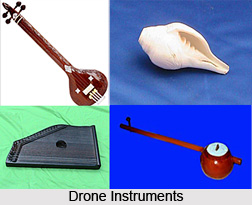 Drone music also known as drone-based music, drone ambient or ambient drone, dronescape or the modern alias dronology is representative of spirituality. This music is a simple musical style that gives emphasis to the use of sustained or repeated sounds, notes, or tone-clusters - called drones. The drone is the base provided in the actual practice of the musical art. The drone represents a spectrum of rich tones gravitating towards the fundamental sa, the sadja (sadja itself means the generation of other notes). This type of drone is the artistic, aesthetic need for a base, but the psychology for feeling such a need has been acquired through its growth in the environment and influence of Indian cultural spirit.
Drone music also known as drone-based music, drone ambient or ambient drone, dronescape or the modern alias dronology is representative of spirituality. This music is a simple musical style that gives emphasis to the use of sustained or repeated sounds, notes, or tone-clusters - called drones. The drone is the base provided in the actual practice of the musical art. The drone represents a spectrum of rich tones gravitating towards the fundamental sa, the sadja (sadja itself means the generation of other notes). This type of drone is the artistic, aesthetic need for a base, but the psychology for feeling such a need has been acquired through its growth in the environment and influence of Indian cultural spirit.
The various qualities that are required - repose, firmness, persistence, involvement, harmony, gravitation- are all present in the sound of the drone instruments of the tambura. To take an objective view, the Indian musician listens to the tambura endowing these qualities to it from himself as a response in resonance. The tambura sound acts as a signal for such responses in the Indian musicians. The context aspects of a raaga as developed during a performance are enhanced by the signalling sound of the tambura. This "basic" note is just a steady note, but a referential note, and a point of departure to be consciously undertaken for the flight of imagination.
In all melodic music, in the primitive, ethnic as well as folk expression, the basic note is the note of prime importance. It is the central point of reference. In India during and after the period of Bharata`s Natyashastra, melodic music went through certain phases of evolution, viz. music as jati-gana, as raaga-jati gana and still later as raaga-gana giving greater emphasis or importance to the sadja grama and to the sadja, the very basis of melody. In earlier association with primitive music, ritual dance and magic, music must have played its role along with the incessant and repetitive rhythms of the drum as nerve medicine (as tranquillizer or exciter) or as an instrument of trance.
Role of Drone Music in Yoga
A basic aspect of yoga is connected with this concept of drone. Sound is said to have a great and immediate impact on the human mind. It is said to demand and get immediate attention and is directly connected with the instinct of self-preservation. The steady sound, or the musical note of the drone, pervades the mind and influences the ever playful mind. It controls or conditions it to its own state or infuses concentration on a single issue: this is the basic need of yoga. There is a psychological truth in saying that creating a steady sound particularly by the human voice requires concentration of mind. This has the ethos of prityahara (returning to the source) mentioned in the 54th canto of Patanjali Yoga Sutra.




















